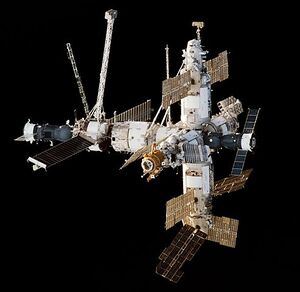Mir (nonfiction): Difference between revisions
No edit summary |
No edit summary |
||
| (3 intermediate revisions by the same user not shown) | |||
| Line 1: | Line 1: | ||
[[File:Mir.jpg|thumb|Mir seen from Space Shuttle Endeavour during STS-89 (9 February 1998).]]'''Mir''' (Russian: Мир, IPA: [ˈmʲir]; lit. peace or world) was a space station that operated in low Earth orbit from 1986 to 2001, run by the Soviet Union and later by Russia. | [[File:Mir.jpg|thumb|Mir seen from Space Shuttle Endeavour during STS-89 (9 February 1998).]]'''Mir''' (Russian: Мир, IPA: [ˈmʲir]; lit. peace or world) was a space station that operated in low Earth orbit from 1986 to 2001, run by the Soviet Union and later by Russia. | ||
Mir was the first modular space station and was assembled in orbit from 1986 to 1996. It had a greater mass than any previous spacecraft. At the time it was the largest artificial satellite in orbit, succeeded by the International Space Station after Mir's orbit decayed. | It was launched on February 20, 1986 from Baikonur Cosmodrome. | ||
Mir was the first modular space station and was assembled in orbit from 1986 to 1996. It had a greater mass than any previous spacecraft. At the time it was the largest artificial satellite in orbit, succeeded by the [[International Space Station (nonfiction)|International Space Station]] after Mir's orbit decayed. | |||
The station served as a microgravity research laboratory in which crews conducted experiments in biology, human biology, physics, astronomy, meteorology and spacecraft systems with a goal of developing technologies required for permanent occupation of space. | The station served as a microgravity research laboratory in which crews conducted experiments in biology, human biology, physics, astronomy, meteorology and spacecraft systems with a goal of developing technologies required for permanent occupation of space. | ||
| Line 12: | Line 14: | ||
<gallery> | <gallery> | ||
File:AESOP.jpg|link=AESOP|[[AESOP]] said to be cause of prophetic dreams among the Mir astronauts. | |||
</gallery> | </gallery> | ||
== Fiction cross-reference == | == Fiction cross-reference == | ||
* [[AESOP]] | |||
== Nonfiction cross-reference == | == Nonfiction cross-reference == | ||
* [[International Space Station (nonfiction)]] | |||
* [[Spacecraft (nonfiction)]] | * [[Spacecraft (nonfiction)]] | ||
Latest revision as of 14:42, 4 November 2017
Mir (Russian: Мир, IPA: [ˈmʲir]; lit. peace or world) was a space station that operated in low Earth orbit from 1986 to 2001, run by the Soviet Union and later by Russia.
It was launched on February 20, 1986 from Baikonur Cosmodrome.
Mir was the first modular space station and was assembled in orbit from 1986 to 1996. It had a greater mass than any previous spacecraft. At the time it was the largest artificial satellite in orbit, succeeded by the International Space Station after Mir's orbit decayed.
The station served as a microgravity research laboratory in which crews conducted experiments in biology, human biology, physics, astronomy, meteorology and spacecraft systems with a goal of developing technologies required for permanent occupation of space.
Mir was the first continuously inhabited long-term research station in orbit and held the record for the longest continuous human presence in space at 3,644 days, until it was surpassed by the ISS on 23 October 2010. It holds the record for the longest single human spaceflight, with Valeri Polyakov spending 437 days and 18 hours on the station between 1994 and 1995. Mir was occupied for a total of twelve and a half years out of its fifteen-year lifespan, having the capacity to support a resident crew of three, or larger crews for short visits.
After funding was cut off, Mir was deorbited on March 23, 2001. The cost of the Mir programme was estimated by former RKA General Director Yuri Koptev in 2001 as $4.2 billion over its lifetime (including development, assembly and orbital operation).
In the News
AESOP said to be cause of prophetic dreams among the Mir astronauts.
Fiction cross-reference
Nonfiction cross-reference
External links:
- Mir @ Wikipedia

